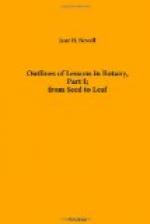The carrot is a fleshy root, as we have already seen. The onion consists of the fleshy bases of last year’s leaves, sheathed by the dried remains of the leaves of former years, from which all nourishment has been drawn. The parallel veining of the leaves is distinctly marked. The stem is a plate at the base, to which these fleshy scales are attached. In the centre, or in the axils of the scales, the newly-forming bulbs can be seen, in onions that are sprouting. If possible, compare other bulbs, as those of Tulip, Hyacinth, or Snowdrop, and the bulb of a Crocus, in which the fleshy part consists of the thickened base of the stem, and the leaves are merely dry scales. This is called a corm.
The potato is a thickened stem. It shows itself to be a stem, because it bears organs. The leaves are reduced to little scales (eyelids), in the axils of which come the buds (eyes). The following delightful experiment has been recommended to me.
In a growing potato plant, direct upwards one of the low shoots and surround it with a little cylinder of stiff carpet paper, stuffed with sphagnum and loam. Cut away the other tuber-disposed shoots as they appear. The enclosed shoot develops into a tuber which stands more or less vertical, and the scales become pretty little leaves. Removing the paper, the tuber and leaves become green, and the latter enlarge a little. A better illustration of the way in which organs adapt themselves to their conditions, and of the meaning of morphology, could hardly be found.
Gray’s First Lessons. Sect. v, 65-88. How Plants Grow. Chap. I, 83-90.
IV.
BUDS AND BRANCHES.
1. There is an astonishing amount to be learned from naked branches, and, if pursued in the right way, the study will be found exceedingly interesting. Professor Beal, in his pamphlet on the New Botany,[1] says:—
“Before the first lesson, each pupil is furnished or told where to procure some specimen for study. If it is winter, and flowers or growing plants cannot be had, give each a branch of a tree or shrub; this branch may be two feet long. The examination of these is made during the usual time for preparing lessons, and not while the class is before the teacher. For the first recitation each is to tell what he has discovered. The specimens are not in sight during the recitation. In learning the lesson, books are not used; for, if they are used, no books will contain a quarter of what the pupil may see for himself. If there is time, each member of the class is allowed a chance to mention anything not named by any of the rest. The teacher may suggest a few other points for study. The pupils are not told what they can see for themselves. An effort is made to keep them working after something which they have not yet discovered. If two members disagree on any point, on the next day, after further study, they are requested




